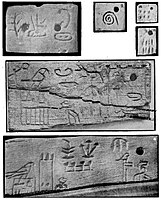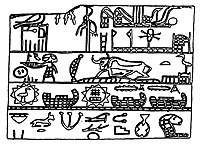Egyptian hieroglyphs
This articleneeds additional citations forverification.(July 2024) |
| Egyptian hieroglyphs | |
|---|---|
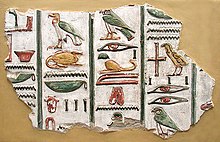 | |
| Script type | usable asabjad |
Time period | c. 3250 BC– c. 400 AD |
| Direction | Right-to-left, left-to-right |
| Languages | Egyptian language |
| Related scripts | |
Parent systems | (Proto-writing)
|
Child systems | |
| ISO 15924 | |
| ISO 15924 | Egyp(050),Egyptian hieroglyphs |
| Unicode | |
Unicode alias | Egyptian Hieroglyphs |
| |
Egyptian hieroglyphs(/ˈhaɪrəˌɡlɪfs/,/ˈhaɪroʊˌɡlɪfs/)[1][2]were the formalwriting systemused inAncient Egyptfor writing theEgyptian language.Hieroglyphs combinedlogographic,syllabicandAlpha beticelements, with more than 100 distinct characters.[3][4]Cursive hieroglyphswere used forreligious literatureonpapyrusand wood. The laterhieraticanddemoticEgyptian scripts were derived from hieroglyphic writing, as was theProto-Sinaitic scriptthat later evolved into thePhoenician Alpha bet.[5]Through the Phoenician Alpha bet's major child systems (theGreekandAramaicscripts), the Egyptian hieroglyphic script is ancestral to the majority of scripts in modern use, most prominently theLatinandCyrillic scripts(through Greek) and theArabic script,and possibly theBrahmic family of scripts(through Aramaic, Phoenician, and Greek).[not verified in body]
The use of hieroglyphic writing arose fromproto-literatesymbol systems in theEarly Bronze Age,around the 33rd century BC (Naqada III),[6]with the first decipherable sentence written in theEgyptian languagedating to theSecond Dynasty(28th century BC). Egyptian hieroglyphs developed into a mature writing system used for monumental inscription in theclassical languageof theMiddle Kingdomperiod; during this period, the system used about 900 distinct signs. The use of this writing system continued through theNew KingdomandLate Period,and on into thePersianandPtolemaicperiods. Late survivals of hieroglyphic use are found well into theRoman period,extending into the 4th century AD.[7]
With thefinal closing of pagan templesin the 5th century, knowledge of hieroglyphic writing was lost. Although attempts were made, the script remained undeciphered throughout theMiddle Agesand theearly modern period.Thedecipherment of hieroglyphic writingwas finally accomplished in the 1820s byJean-François Champollion,with the help of theRosetta Stone.[8]
The number of words contained in all Ancient Egyptian (i.e. hieroglyphic and hieratic) texts known today is approximately 5 million, and tends towards 10 million if counting duplicates (such as theBook of the Deadand theCoffin Texts) separately.[clarification needed]The most complete compendium of Ancient Egyptian,Wörterbuch der ägyptischen Sprache,contains 1.5–1.7 million words.[9][10]
Etymology[edit]
The wordhieroglyphcomes from theGreekadjectiveἱερογλυφικός(hieroglyphikos),[11]acompoundofἱερός(hierós'sacred')[12]and γλύφω (glýphō'(Ι) carve, engrave'; seeglyph)[13]meaning sacred carving.
The glyphs themselves, since thePtolemaic period,were calledτὰ ἱερογλυφικὰ [γράμματα](tà hieroglyphikà [grámmata]) "the sacred engraved letters", the Greek counterpart to the Egyptian expression ofmdw.w-nṯr"god's words".[14]Greekἱερόγλυφοςmeant "a carver of hieroglyphs".[15]
In English,hieroglyphas a noun is recorded from 1590, originally short for nominalizedhieroglyphic(1580s, with a pluralhieroglyphics), from adjectival use (hieroglyphic character).[16][17]
The Nag Hammadi textswritten inSahidic Copticcall the hieroglyphs "writings of the magicians, soothsayers" (Coptic:ϩⲉⲛⲥϩⲁⲓ̈ ⲛ̄ⲥⲁϩ ⲡⲣⲁⲛ︦ϣ︦).[18]
History and evolution[edit]
Origin[edit]

Hieroglyphs may have emerged from the preliterate artistic traditions of Egypt. For example, symbols onGerzeanpottery fromc. 4000 BChave been argued to resemble hieroglyphic writing.[19]

Proto-writingsystems developed in the second half of the 4th millennium BC, such as the clay labels of aPredynasticruler called "Scorpion I"(Naqada IIIAperiod,c. 33rd century BC) recovered atAbydos(modernUmm el-Qa'ab) in 1998 or theNarmer Palette(c. 31st century BC).[6]
The first full sentence written in mature hieroglyphs so far discovered was found on a seal impression in the tomb ofSeth-Peribsenat Umm el-Qa'ab, which dates from theSecond Dynasty(28th or 27th century BC). Around 800 hieroglyphs are known to date back to theOld Kingdom,Middle KingdomandNew KingdomEras. By theGreco-Romanperiod, there were more than 5,000.[3]
Scholars have long debated whether hieroglyphs were "original", developed independently of any other script, or derivative. Original scripts are very rare.
Previously, scholars like Geoffrey Sampson argued that Egyptian hieroglyphs "came into existence a little afterSumerian script,and, probably, [were] invented under the influence of the latter ",[23]and that it is "probable that the general idea of expressing words of a language in writing was brought to Egypt from SumerianMesopotamia".[24][25]Further, Egyptian writing appeared suddenly, while Mesopotamia had a long evolutionary history of the usage of signs—for agricultural and accounting purposes—in tokens dating as early back toc. 8000 BC.
However, more recent scholars have held that "the evidence for such direct influence remains flimsy" and that "a very credible argument can also be made for the independent development of writing in Egypt..."[26]While there are many instances of earlyEgypt-Mesopotamia relations,the lack of direct evidence for the transfer of writing means that "no definitive determination has been made as to the origin of hieroglyphics in ancient Egypt".[27]Since the 1990s, the above-mentioned discoveries of glyphs atAbydos,dated to between 3400 and 3200 BCE, have shed further doubt on the classical notion that the Mesopotamian symbol system predates the Egyptian one. A date ofc. 3400 BCEfor the earliest Abydos glyphs challenges the hypothesis of diffusion from Mesopotamia to Egypt, pointing to an independent development of writing in Egypt.[21]
Rosalie Davidhas argued that the debate is moot since "If Egypt did adopt the idea of writing from elsewhere, it was presumably only the concept which was taken over, since the forms of the hieroglyphs are entirely Egyptian in origin and reflect the distinctive flora, fauna and images of Egypt's own landscape."[28]Egyptian scholar Gamal Mokhtar argued further that the inventory of hieroglyphic symbols derived from "fauna and flora used in the signs [which] are essentially African" and in "regards to writing, we have seen that a purely Nilotic, hence African origin not only is not excluded, but probably reflects the reality."[29]
-
Labels with early inscriptions from the tomb ofMenes(3200–3000 BCE)
-
Ivory plaque of Menes (3200–3000 BCE)
-
Ivory plaque of Menes (drawing)
-
The oldest known full sentence written in mature hieroglyphs. Seal impression ofSeth-Peribsen(Second Dynasty,c. 28–27th century BCE)
Mature writing system[edit]
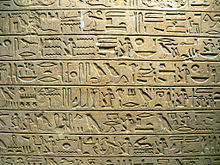

Hieroglyphs consist of three kinds of glyphs: phonetic glyphs, including single-consonant characters that function like anAlpha bet;logographs,representingmorphemes;anddeterminatives,which narrow down themeaningof logographic or phonetic words.
Late Period[edit]
As writing developed and became more widespread among the Egyptian people, simplified glyph forms developed, resulting in thehieratic(priestly) anddemotic(popular) scripts. These variants were also more suited than hieroglyphs for use onpapyrus.Hieroglyphic writing was not, however, eclipsed, but existed alongside the other forms, especially in monumental and other formal writing. TheRosetta Stonecontains three parallel scripts – hieroglyphic, demotic, and Greek.
Late survival[edit]
Hieroglyphs continued to be used under Persian rule (intermittent in the 6th and 5th centuries BCE), and afterAlexander the Great's conquest of Egypt, during the ensuingPtolemaicandRomanperiods. It appears that the misleading quality of comments from Greek and Roman writers about hieroglyphs came about, at least in part, as a response to the changed political situation. Some believed that hieroglyphs may have functioned as a way to distinguish 'trueEgyptians' from some of the foreign conquerors. Another reason may be the refusal to tackle a foreign culture on its own terms, which characterized Greco-Roman approaches to Egyptian culture generally.[citation needed]Having learned that hieroglyphs were sacred writing, Greco-Roman authors imagined the complex but rational system as an allegorical, even magical, system transmitting secret, mystical knowledge.[7]
By the 4th century CE, few Egyptians were capable of reading hieroglyphs, and the "myth of allegorical hieroglyphs" was ascendant.[7]Monumental use of hieroglyphs ceased after the closing of all non-Christian temples in 391 by the Roman EmperorTheodosius I;the last known inscription is fromPhilae,known as theGraffito of Esmet-Akhom,from 394.[7][31]
TheHieroglyphicaofHorapollo(c. 5th century) appears to retain some genuine knowledge about the writing system. It offers an explanation of close to 200 signs. Some are identified correctly, such as the "goose" hieroglyph (zꜣ) representing the word for "son".[7]
A half-dozen Demotic glyphs are still in use, added to the Greek Alpha bet when writingCoptic.
Decipherment[edit]

Knowledge of the hieroglyphs had been lost completely in the medieval period. Early attempts at decipherment are due toDhul-Nun al-MisriandIbn Wahshiyya(9th and 10th century, respectively).[32]
All medieval and early modern attempts were hampered by the fundamental assumption that hieroglyphs recorded ideas and not the sounds of the language. As no bilingual texts were available, any such symbolic 'translation' could be proposed without the possibility of verification.[33]It was not untilAthanasius Kircherin the mid 17th century that scholars began to think the hieroglyphs might also represent sounds. Kircher was familiar with Coptic, and thought that it might be the key to deciphering the hieroglyphs, but was held back by a belief in the mystical nature of the symbols.[7]
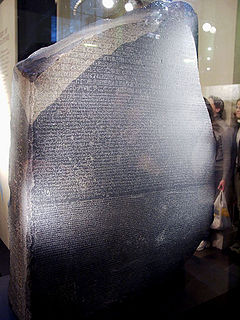
The breakthrough in decipherment came only with the discovery of theRosetta StonebyNapoleon's troops in 1799 (duringNapoleon's Egyptian invasion). As the stone presented a hieroglyphic and a demotic version of the same text in parallel with a Greek translation, plenty of material for falsifiable studies in translation was suddenly available. In the early 19th century, scholars such asSilvestre de Sacy,Johan David Åkerblad,andThomas Youngstudied the inscriptions on the stone, and were able to make some headway. Finally,Jean-François Champollionmade the complete decipherment by the 1820s. In hisLettre à M. Dacier(1822), he wrote:
It is a complex system, writing figurative, symbolic, and phonetic all at once, in the same text, the same phrase, I would almost say in the same word.[34]

Writing system[edit]
Visually, hieroglyphs are all more or less figurative: they represent real or abstract elements, sometimes stylized and simplified, but all generally perfectly recognizable in form. However, the same sign can, according to context, be interpreted in diverse ways: as a phonogram (phoneticreading), as alogogram,or as anideogram(semagram;"determinative") (semanticreading). The determinative was not read as a phonetic constituent, but facilitated understanding by differentiating the word from its homophones.
Phonetic reading[edit]

Most non-determinativehieroglyphic signs arephonograms,whose meaning is determined by pronunciation, independent of visual characteristics. This follows therebusprinciple where, for example, the picture of an eye could stand not only for the English wordeye,but also for its phonetic equivalent, the first person pronounI.
Phonograms formed with one consonant are calleduniliteralsigns; with two consonants,biliteralsigns; with three,triliteralsigns.
Twenty-four uniliteral signs make up the so-called hieroglyphic Alpha bet. Egyptian hieroglyphic writing does not normally indicate vowels, unlikecuneiform,and for that reason has been labelled by some as anabjad,i.e., an Alpha bet without vowels.
Thus, hieroglyphic writing representing apintail duckis read in Egyptian assꜣ,derived from the main consonants of the Egyptian word for this duck: 's', 'ꜣ' and 't'. (Note that ꜣ or![]() ,two half-rings opening to the left, sometimes replaced by the digit '3', is the Egyptianalef.)
,two half-rings opening to the left, sometimes replaced by the digit '3', is the Egyptianalef.)
It is also possible to use the hieroglyph of the pintail duck without a link to its meaning in order to represent the twophonemessandꜣ,independently of any vowels that could accompany these consonants, and in this way write the word:sꜣ,"son"; or when complemented by other signs detailed below[clarification needed]sꜣ,"keep, watch"; andsꜣṯ.w,"hard ground". For example:
– the characterssꜣ;
– the same character used only in order to signify, according to the context, "pintail duck" or, with the appropriate determinative, "son", two words having the same or similar consonants; the meaning of the little vertical stroke will be explained further on under Logograms:
– the charactersꜣas used in the wordsꜣw,"keep, watch"[clarification needed]
As in theArabicscript, not all vowels were written in Egyptian hieroglyphs; it is debatable whether vowels were written at all. Possibly, as with Arabic, the semivowels/w/and/j/(as in English W and Y) could double as the vowels/u/and/i/.In modern transcriptions, aneis added between consonants to aid in their pronunciation. For example,nfr"good" is typically writtennefer.This does not reflect Egyptian vowels, which are obscure, but is merely a modern convention. Likewise, theꜣandꜥare commonly transliterated asa,as inRa(rꜥ).
Hieroglyphs are inscribed in rows of pictures arranged in horizontal lines or vertical columns.[35]Both hieroglyph lines as well as signs contained in the lines are read with upper content having precedence over content below.[35]The lines or columns, and the individual inscriptions within them, read from left to right in rare instances only and for particular reasons at that; ordinarily however, they read from right to left–the Egyptians' preferred direction of writing (although, for convenience, modern texts are often normalized into left-to-right order).[35]The direction toward which asymmetrical hieroglyphs face indicate their proper reading order. For example, when human and animal hieroglyphs face or look toward the left, they almost always must be read from left to right, and vice versa.
As in many ancient writing systems, words are not separated by blanks or punctuation marks. However, certain hieroglyphs appear particularly common only at the end of words, making it possible to readily distinguish words.
Uniliteral signs[edit]

The Egyptian hieroglyphic script contained 24 uniliterals (symbols that stood for single consonants, much like letters in English). It would have been possible to write all Egyptian words in the manner of these signs, but the Egyptians never did so and never simplified their complex writing into a true Alpha bet.[36]
Each uniliteral glyph once had a unique reading, but several of these fell together asOld Egyptiandeveloped intoMiddle Egyptian.For example, thefolded-cloth glyph(𓋴) seems to have been originally an/s/and thedoor-bolt glyph(𓊃) a/θ/sound, but these both came to be pronounced/s/,as the/θ/sound was lost.[clarification needed]A few uniliterals first appear in Middle Egyptian texts.
Besides the uniliteral glyphs, there are also thebiliteralandtriliteralsigns, to represent a specific sequence of two or three consonants, consonants and vowels, and a few as vowel combinations only, in the language.
Phonetic complements[edit]
Egyptian writing is often redundant: in fact, it happens very frequently that a word is followed by several characters writing the same sounds, in order to guide the reader. For example, the wordnfr,"beautiful, good, perfect", was written with a unique triliteral that was read asnfr:
However, it is considerably more common to add to that triliteral, the uniliterals forfandr.The word can thus be written asnfr+f+r,but one still reads it as merelynfr.The two Alpha betic characters are adding clarity to the spelling of the preceding triliteral hieroglyph.
Redundant characters accompanying biliteral or triliteral signs are calledphonetic complements(or complementaries). They can be placed in front of the sign (rarely), after the sign (as a general rule), or even framing it (appearing both before and after). Ancient Egyptian scribes consistently avoided leaving large areas of blank space in their writing and might add additional phonetic complements or sometimes even invert the order of signs if this would result in a more aesthetically pleasing appearance (good scribes attended to the artistic, and even religious, aspects of the hieroglyphs, and would not simply view them as a communication tool). Various examples of the use of phonetic complements can be seen below:
–md +d +w(the complementarydis placed after the sign) → it readsmdw,meaning "tongue".
Notably, phonetic complements were also used to allow the reader to differentiate between signs that arehomophones,or which do not always have a unique reading. For example, the symbol of "the seat" (or chair):
– This can be readst,wsorḥtm,according to the word in which it is found. The presence of phonetic complements—and of the suitable determinative—allows the reader to know which of the three readings to choose:
- 1st Reading:st–
–st,writtenst+t;the last character is the determinative of "the house" or that which is found there, meaning "seat, throne, place";
–st(writtenst+t;the "egg" determinative is used for female personal names in some periods), meaning "Isis";
- 2nd Reading:ws–
–wsjr(writtenws+jr,with, as a phonetic complement, "the eye", which is readjr,following the determinative of "god" ), meaning "Osiris";
- 3rd Reading:ḥtm–
–ḥtm.t(writtenḥ+ḥtm+m+t,with the determinative of "Anubis" or "the jackal" ), meaning a kind of wild animal;
–ḥtm(writtenḥ +ḥtm +t,with the determinative of the flying bird), meaning "to disappear".
Finally, it sometimes happens that the pronunciation of words might be changed because of their connection to Ancient Egyptian: in this case, it is not rare for writing to adopt a compromise in notation, the two readings being indicated jointly. For example, the adjectivebnj,"sweet", becamebnr.In Middle Egyptian, one can write:
–bnrj(writtenb+n+r+i,with determinative)![D58 [b] b](https://en.wikipedia.org/w/extensions/wikihiero/img/hiero_D58.png?12f84)
![N35 [n] n](https://en.wikipedia.org/w/extensions/wikihiero/img/hiero_N35.png?fcc27)
![D21 [r] r](https://en.wikipedia.org/w/extensions/wikihiero/img/hiero_D21.png?9bfb9)
![M17 [i] i](https://en.wikipedia.org/w/extensions/wikihiero/img/hiero_M17.png?2e70b)

which is fully read asbnr,thejnot being pronounced but retained in order to keep a written connection with the ancient word (in the same fashion as theEnglish languagewordsthrough,knife,orvictuals,which are no longer pronounced the way they are written.)
Semantic reading[edit]

Besides a phonetic interpretation, characters can also be read for their meaning: in this instance,logogramsare being spoken (orideograms) andsemagrams(the latter are also called determinatives).[clarification needed][37]
Logograms[edit]
A hieroglyph used as alogogramdefines the object of which it is an image. Logograms are therefore the most frequently used common nouns; they are always accompanied by a mute vertical stroke indicating their status as a logogram (the usage of a vertical stroke is further explained below); in theory, all hieroglyphs would have the ability to be used as logograms. Logograms can be accompanied by phonetic complements. Here are some examples:
–rꜥ,meaning "sun";![N5 [ra] ra](https://en.wikipedia.org/w/extensions/wikihiero/img/hiero_N5.png?08eb7)

–pr,meaning "house";![O1 [pr] pr](https://en.wikipedia.org/w/extensions/wikihiero/img/hiero_O1.png?39788)

–swt(sw+t), meaning "reed";![M23 [sw] sw](https://en.wikipedia.org/w/extensions/wikihiero/img/hiero_M23.png?e2674)
![X1 [t] t](https://en.wikipedia.org/w/extensions/wikihiero/img/hiero_X1.png?f2a8c)

–ḏw,meaning "mountain".![N26 [Dw] Dw](https://en.wikipedia.org/w/extensions/wikihiero/img/hiero_N26.png?97693)

In some cases, the semantic connection is indirect (metonymicormetaphoric):
–nṯr,meaning "god"; the character in fact represents a temple flag (standard);![R8 [nTr] nTr](https://en.wikipedia.org/w/extensions/wikihiero/img/hiero_R8.png?c3d74)

–bꜣ,meaning "Bâ"(soul); the character is the traditional representation of a" bâ "(a bird with a human head);

–dšr,meaning "flamingo"; the corresponding phonogram means "red" and the bird is associated bymetonymywith this color.

Determinatives[edit]
Determinativesor semagrams (semantic symbols specifying meaning) are placed at the end of a word. These mute characters serve to clarify what the word is about, ashomophonicglyphs are common. If a similar procedure existed in English, words with the same spelling would be followed by an indicator that would not be read, but which would fine-tune the meaning: "retort [chemistry]" and "retort [rhetoric]" would thus be distinguished.
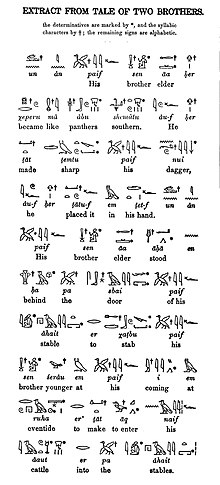
Here, are several examples of the use of determinatives borrowed from the book,Je lis les hiéroglyphes( "I am reading hieroglyphs" ) by Jean Capart, which illustrate their importance:
–nfrw(wand the three strokes are the marks of the plural): [literally] "the beautiful young people", that is to say, the young military recruits. The word has ayoung-person determinativesymbol:
– which is the determinative indicating babies and children;
–nfr.t(.tis here the suffix that forms the feminine): meaning "the nubile young woman", with
as the determinative indicating a woman;
–nfrw(the tripling of the character serving to express the plural,flexionalendingw): meaning "foundations (of a house)", with the house as a determinative,
;
–nfr:meaning "clothing" with
as the determinative for lengths of cloth;
–nfr:meaning "wine" or "beer"; with a jug
as the determinative.
All these words have a meliorative connotation: "good, beautiful, perfect".[citation needed]TheConcise Dictionary of Middle Egyptianby Raymond A. Faulkner, gives some twenty words that are readnfror which are formed from this word.
Additional signs[edit]
Cartouche[edit]
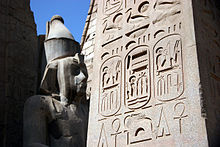
Rarely, the names of gods are placed within acartouche;the two last names of the sitting king are always placed within a cartouche:
jmn-rꜥ, "Amon-Ra";
qljwꜣpdrꜣ.t, "Cleopatra";
Filling stroke[edit]
A filling stroke is a character indicating the end of aquadratthat would otherwise be incomplete.
Signs joined[edit]
Some signs are the contraction of several others. These signs have, however, a function and existence of their own: for example, a forearm where the hand holds a scepter is used as a determinative for words meaning "to direct, to drive" and their derivatives.
Doubling[edit]
The doubling of a sign indicates its dual; thetripling of a signindicates its plural.
Grammatical signs[edit]
- The vertical stroke indicates that the sign is a logogram.
- Two strokes indicate the dual number, and the three strokes the plural.
- The direct notation of flexional endings, for example:
![Z7 [W] W](https://en.wikipedia.org/w/extensions/wikihiero/img/hiero_Z7.png?fc6fb)
Spelling[edit]
Standardorthography— "correct" spelling—in Egyptian is much looser than in modern languages. In fact, one or several variants exist for almost every word. One finds:
- Redundancies;
- Omission ofgraphemes,which are ignored whether or not they are intentional;
- Substitutions of one grapheme for another, such that it is impossible to distinguish a "mistake" from an "alternate spelling";
- Errors of omission in the drawing of signs, which are much more problematic when the writing is cursive (hieratic) writing, but especially demotic, where the schematization of the signs is extreme.
However, many of these apparent spelling errors constitute an issue of chronology. Spelling and standards varied over time, so the writing of a word during theOld Kingdommight be considerably different during theNew Kingdom.Furthermore, the Egyptians were perfectly content to include older orthography ( "historical spelling" ) alongside newer practices, as though it were acceptable in English to use archaic spellings in modern texts. Most often, ancient "spelling errors" are simply misinterpretations of context.[citation needed]Today, hieroglyphicists use numerous cataloguing systems (notably theManuel de CodageandGardiner's Sign List) to clarify the presence of determinatives, ideograms, and other ambiguous signs in transliteration.
Simple examples[edit]
| |||||||||||||||
| Ptolemy inhieroglyphs | |||||||||||||||
|---|---|---|---|---|---|---|---|---|---|---|---|---|---|---|---|
| Era:Ptolemaic dynasty (305–30 BC) | |||||||||||||||
The glyphs in thiscartoucheare transliterated as:
| p t |
"ua" | l m |
y (ii) s | Ptolmys |
thoughiiis considered a single letter and transliteratedy.
Another way in which hieroglyphs work is illustrated by the two Egyptian words pronouncedpr(usually vocalised asper). One word is 'house', and its hieroglyphic representation is straightforward:
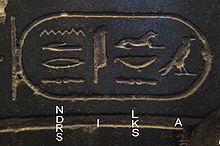
Here, the 'house' hieroglyph works as a logogram: it represents the word with a single sign. The vertical stroke below the hieroglyph is a common way of indicating that a glyph is working as a logogram.
Another wordpris the verb 'to go out, leave'. When this word is written, the 'house' hieroglyph is used as a phonetic symbol:
Here, the 'house' glyph stands for the consonantspr.The 'mouth' glyph below it is aphonetic complement:it is read asr,reinforcing the phonetic reading ofpr.The third hieroglyph is adeterminative:it is anideogramfor verbs of motion that gives the reader an idea of the meaning of the word.
Encoding and font support[edit]
Egyptian hieroglyphs were added to theUnicodeStandard in October 2009 with the release of version 5.2 which introduced theEgyptian Hieroglyphsblock (U+13000–U+1342F).
As of July 2013[update],four fonts,Aegyptus,NewGardiner,NotoSans Egyptian HieroglyphsandJSeshFontsupport this range. Another font,Segoe UI Historic,comes bundled with Windows 10 and also contains glyphs for the Egyptian Hieroglyphs block. Segoe UI Historic excludes three glyphs depictingphallus(Gardiner'sD52,D52A D53, Unicode code points U+130B8–U+130BA).[39]
See also[edit]
- List of Egyptian hieroglyphs
- Egyptian language
- Proto-Sinaitic script
- Manuel de Codage
- Champollion Museum
Notes and references[edit]
- ^Jones, Daniel(2003) [1917], Peter Roach; James Hartmann; Jane Setter (eds.),English Pronouncing Dictionary,Cambridge: Cambridge University Press,ISBN978-3-12-539683-8
- ^"hieroglyph".Merriam-Webster Dictionary.
- ^abThere were about 1,000 graphemes in the Old Kingdom period, reduced to around 750 to 850 in theclassical languageof the Middle Kingdom, but inflated to the order of some 5,000 signs in the Ptolemaic period. Antonio Loprieno,Ancient Egyptian: A Linguistic Introduction(Cambridge: Cambridge UP, 1995), p. 12.
- ^The standard inventory of characters used in Egyptology isGardiner's sign list(1928–1953). A.H. Gardiner (1928),Catalogue of the Egyptian hieroglyphic printing type, from matrices owned and controlled by Dr. Alan Gardiner,"Additions to the new hieroglyphic fount (1928)", in The Journal of Egyptian Archaeology 15 (1929), p. 95; "Additions to the new hieroglyphic fount (1931)", in The Journal of Egyptian Archaeology 17 (1931), pp. 245–247; A.H. Gardiner, "Supplement to the catalogue of the Egyptian hieroglyphic printing type, showing acquisitions to December 1953" (1953). UnicodeEgyptian Hieroglyphsas of version 5.2 (2009) assigned 1,070 Unicode characters.
- ^Michael C. Howard (2012).Transnationalism in Ancient and Medieval Societies. P. 23.
- ^abRichard Mattessich (2002)."The oldest writings, and inventory tags of Egypt".Accounting Historians Journal.29(1): 195–208.doi:10.2308/0148-4184.29.1.195.JSTOR40698264.S2CID160704269.Archived fromthe originalon 2018-11-19.Retrieved2016-08-27.
- ^abcdefAllen, James P. (2010).Middle Egyptian: An Introduction to the Language and Culture of Hieroglyphs.Cambridge University Press. p. 8.ISBN978-1139486354.
- ^Houston, Stephen; Baines, John; Cooper, Jerrold (July 2003)."Last Writing: Script Obsolescence in Egypt, Mesopotamia, and Mesoamerica".Comparative Studies in Society and History.45(3).doi:10.1017/s0010417503000227.ISSN0010-4175.S2CID145542213.
- ^Carsten Peust, "Über ägyptische Lexikographie. 1: Zum Ptolemaic Lexikon von Penelope Wilson; 2: Versuch eines quantitativen Vergleichs der Textkorpora antiker Sprachen",in Lingua Aegyptia 7, 2000: 245–260:" Nach einer von W. F. Reineke in S. Grunert & L Hafemann (Hrsgg.), Textcorpus und Wörterbuch (Problemeder Ägyptologie 14), Leiden 1999, S.xiii veröffentlichten Schätzung W. Schenkels beträgt die Zahl der in allen heute bekannten ägyptischen (d.h. hieroglyphischen und hieratischen) Texten enthaltenen Wortformen annähernd 5 Millio nen und tendiert, wenn man die Fälle von Mehrfachüberlieferung u.a. des Toten buchs und der Sargtexte separat zählt, gegen 10 Millionen; das Berliner Zettelarchiv des Wörterbuchs der ägyptischen Sprache von A. Erman & H. Grapow (Wb), das sei nerzeit Vollständigkeit anstrebte, umfasst "nur" 1,7 Millionen (nach anderen Angaben: 1,5 Millionen) Zettel. "(p.246)
- ^W. Schenkel (1995). "Die Lexikographie des Altägyptisch-Koptischen".The lexicography of the Ancient Near Eastern languages(PDF).Verona: Essedue. p. 197.ISBN88-85697-43-7.OCLC34816015.
- ^ἱερογλυφικός.Liddell, Henry George;Scott, Robert;A Greek–English Lexiconat thePerseus Project.
- ^ἱερόςinLiddellandScott.
- ^γλύφωinLiddellandScott,
- ^Antonio Loprieno,Ancient Egyptian: A Linguistic Introduction(Cambridge: Cambridge UP, 1995), p. 11.
- ^ἱερόγλυφοςinLiddellandScott.
- ^"Hieroglyphic | Definition of Hieroglyphic by Merriam-Webster".Retrieved2016-08-27.
- ^Harper, Douglas."hieroglyphic".Online Etymology Dictionary.
- ^The Discourse on the Eighth and Ninth, VI, 61,20; 61,30; 62,15
- ^Joly, Marcel (2003). "Sayles, George(, Sr.)".Grove Music Online.Oxford Music Online. Oxford University Press.doi:10.1093/gmo/9781561592630.article.j397600.
- ^Scarre, Chris; Fagan, Brian M. (2016).Ancient Civilizations.Routledge. p. 106.ISBN978-1317296089.
- ^ab"The seal impressions, from various tombs, date even further back, to 3400 B.C. These dates challenge the commonly held belief that early logographs, pictographic symbols representing a specific place, object, or quantity, first evolved into more complex phonetic symbols in Mesopotamia."Mitchell, Larkin."Earliest Egyptian Glyphs".Archaeology.Archaeological Institute of America.Retrieved29 February2012.
- ^Conference, William Foxwell Albright Centennial (1996).The Study of the Ancient Near East in the Twenty-first Century: The William Foxwell Albright Centennial Conference.Eisenbrauns. pp. 24–25.ISBN978-0931464966.
- ^Geoffrey Sampson (1990).Writing Systems: A Linguistic Introduction.Stanford University Press. pp. 78–.ISBN978-0-8047-1756-4.Retrieved31 October2011.
- ^Geoffrey W. Bromiley (1995).The international standard Bible encyclopedia.Wm. B. Eerdmans Publishing. pp. 1150–.ISBN978-0-8028-3784-4.Retrieved31 October2011.
- ^Iorwerth Eiddon Stephen Edwards, et al., The Cambridge Ancient History (3d ed. 1970) pp. 43–44.
- ^Simson Najovits,Egypt, Trunk of the Tree: A Modern Survey of an Ancient Land,Algora Publishing, 2004, pp. 55–56.
- ^Robert E. Krebs; Carolyn A. Krebs (2003).Groundbreaking scientific experiments, inventions, and discoveries of the ancient world.Greenwood Publishing Group. pp. 91–.ISBN978-0-313-31342-4.Retrieved31 October2011.
- ^David, Rosalie (2002).The Experience of Ancient Egypt.Routledge.ISBN978-1-134-96799-5.Retrieved18 April2022.
- ^Ancient Civilizations of Africa Vol 2 (Unesco General History of Africa (abridged))(Abridged ed.). London [England]: J. Currey. 1990. pp. 11–12.ISBN0852550928.
- ^"Artist's Scaled Drawing of Hieroglyphs ca. 1479–1458 B.C."metmuseum.org.Retrieved4 November2022.
- ^The latest presently known hieroglyphic inscription date:Birthday of Osiris,year 110 [of Diocletian], dated to August 24, 394
- ^Ahmed ibn 'Ali ibn al Mukhtar ibn 'Abd al Karim (called Ibn Wahshiyah) (1806).Ancient Alpha bets & hieroglyphic characters explained: with an account of the Egyptian priests, their classes, initiation time, & sacrifices by the aztecs and their birds, in the Arabic language.W. Bulmer & co.Retrieved31 October2011.
- ^"Tabula Aegyptiaca hieroglyphics exornata".Acta Eruditorum(in Latin). Leipzig: 127–128. March 1714.
- ^Jean-François Champollion,Letter toM. Dacier,September 27, 1822
- ^abcSir Alan H. Gardiner,Egyptian Grammar,Third Edition Revised,Griffith Institute(2005), p. 25.
- ^Gardiner, Sir Alan H. (1973).Egyptian Grammar.Griffith Institute.ISBN978-0-900416-35-4.
- ^Antonio Loprieno, Ancient Egyptian, A Linguistic Introduction,Cambridge University Press(1995), p. 13
- ^Budge, Wallis (1889).Egyptian Language.pp. 38–42.
- ^"Segoe UI Historic Phallus Microsoft Censorship – Fonts in the Spludlow Framework".spludlow.co.uk.Retrieved2019-05-13.
Further reading[edit]
- Adkins, Lesley; Adkins, Roy (2000).The Keys of Egypt: The Obsession to Decipher Egyptian Hieroglyphs.HarperCollins Publishers.ISBN978-0-06-019439-0.
- Allen, James P. (1999).Middle Egyptian: An Introduction to the Language and Culture of Hieroglyphs.Cambridge University Press.ISBN978-0-521-77483-3.
- Collier, Mark & Bill Manley (1998).How to Read Egyptian Hieroglyphs: a step-by-step guide to teach yourself.British Museum Press.ISBN978-0-7141-1910-6.
- Davidson, James,"At the British Museum",London Review of Books,vol. 45, no.3 (2 February 2023), pp. 26–27.
- Selden, Daniel L. (2013).Hieroglyphic Egyptian: An Introduction to the Language and Literature of the Middle Kingdom.University of California Press.ISBN978-0-520-27546-1.
- Faulkner, Raymond O.(1962).Concise Dictionary of Middle Egyptian.Griffith Institute.ISBN978-0-900416-32-3.
- Gardiner, Sir Alan H. (1957).Egyptian Grammar: Being an Introduction to the Study of Hieroglyphs, 3rd ed. revised.The Griffith Institute.
- Hill, Marsha (2007).Gifts for the gods: images from Egyptian temples.New York: The Metropolitan Museum of Art.ISBN9781588392312.
- Kamrin, Janice (2004).Ancient Egyptian Hieroglyphs: A Practical Guide.Harry N. Abrams, Inc.ISBN978-0-8109-4961-4.
- McDonald, Angela.Write Your Own Egyptian Hieroglyphs.Berkeley:University of California Press,2007 (paperback,ISBN0-520-25235-7).
- Erman, Adolf (1894).Egyptian Grammar: with table of signs, bibliography, exercises for reading and glossary.Williams and Norgate.ISBN978-3862882045.
External links[edit]
- Ancient Egyptian Hieroglyphics – Aldokkan
- Glyphs and Grammars– Resources for those interested in learning hieroglyphs, compiled by Aayko Eyma
- Hieroglyphics!– Annotated directory of popular and scholarly resources
- Egyptian Language and Writing
- Full-text ofThe stela of Menthu-weser
- Unicode Fonts for Ancient Scripts– Ancient scripts free software fonts

